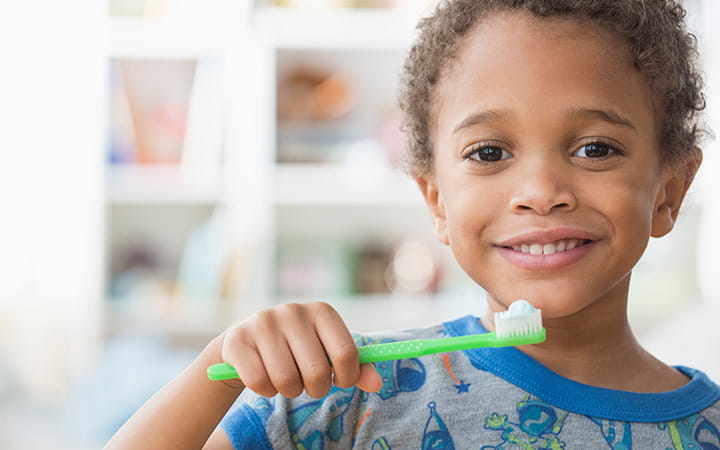Top Toothbrushing Tips for Kids
October 04, 2020
 University Hospitals Rainbow Babies & Children'sExperts in Children's Health
University Hospitals Rainbow Babies & Children'sExperts in Children's Health

Good habits are developed from an early age. Here are seven toothbrushing tips for children from UH Rainbow pediatric dentist Margaret Ferretti, DMD, to help parents create good dental hygiene habits.
Start Early
Even before your child’s teeth have erupted, it’s important to start mouth care. Using a damp washcloth or piece of gauze, gently rub it over your infant’s gums to help clean the mouth. Brushing your child’s teeth should begin when the first tooth appears. Use a small amount of fluoride toothpaste, about the size of a grain of rice, on a soft-bristled toothbrush. When your child is about 3, you can use a pea-sized amount of toothpaste. Your child will need help brushing his or her teeth until the age of about 7 or 8. The single best way to remove plaque – a thin, sticky film loaded with bacteria – from teeth and gums is to brush teeth properly.
Proper Brushing Technique
Because every mouth is different, there is more than one brushing technique that has proven to be effective. Deciding which technique is most appropriate for your child depends largely on the positioning of your child’s teeth and on gum condition. Consult your child’s pediatric dentist to determine which brushing technique is best for your child’s mouth. Generally, most dentists recommend a circular technique for brushing. This includes brushing only a small group of teeth at a time – gradually covering the entire mouth. A circular or elliptical motion is important, as using a back-and-forth motion may cause:
- Receding gums
- Exposed and sensitive root surfaces
- Wearing down of the crown and root surfaces at the gum line
Dr. Ferretti recommends this brushing method:
- Step 1: Place the toothbrush beside the teeth at a 45-degree angle.
- Step 2: Gently brush only a small group of teeth at a time (in a circular or elliptical motion) until the entire mouth is covered.
- Step 3: Brush the outside of the teeth, the inside and the chewing surfaces.
- Step 4: Gently brush the tongue to remove bacteria and freshen breath.
- Step 5: Repeat steps 1 through 4 at least twice daily, especially after meals and snacks.
Type of Toothbrush
A toothbrush head should be small – about 1 inch by ½ inch – and should have a handle suitable for firm grasping. The bristles of the brush should be soft, nylon and rounded at the ends. This helps ensure that the brush bristles are kind to the gums and tooth surfaces, Dr. Ferretti says.
“Soft, polished bristles allow you to reach into the crevices between the teeth and gums to remove plaque without damaging the gums,” Dr. Ferretti says. “Some brushes are too abrasive and can wear down the enamel on teeth.”
How Often to Brush
Generally, brushing is recommended twice a day for at least two minutes each time. People generally think they are brushing long enough, when, in fact, most people spend less than one minute brushing. In addition, it is generally better to brush two minutes twice a day instead of brushing quickly five or more times throughout the day.
Dr. Ferretti advises brushing teeth during the day while at school or play.
“Keeping a toothbrush handy – in a desk or backpack – increases the chance that your child will brush during the day,” she says.
Related Links
The pediatric dentists at the UH Rainbow Dental Center can spot warning signs of problems before they become emergencies, preventing painful and expensive dental problems from developing.


